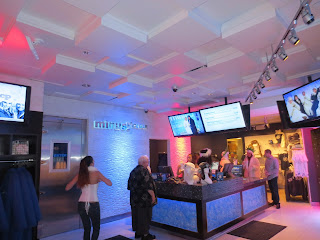
The East River Ferry was launched in June 2011 as a three-year pilot project. The project was so successful that it was extended this winter to continue through at least 2019. The East River Ferry currently stops at terminals in Long Island City, Brooklyn Bridge DUMBO stop (Brooklyn side), Williamsburg, Green Point, Wall Street, and Midtown Manhattan. The ferry runs in two directions from Brooklyn Bridge - southbound to Wall street ( 5 minutes ride) and northbound – to East 33 in Manhattan.

And there is free connecting shuttle bus that runs on a loop through Midtown. The ferry runs every 15- 20 minutes in morning and afternoon rush hours of working days , and every hour during the weekend day. Total ride form DUMBO to Midtown is 20 minutes. The full schedule can be found here.
The first East River ferry was established in 1642 by Cornelius Dircksen, connecting present day Williamsburg, Brooklyn to a small Peck Slip street in Manhattan, where Dircksen kept an inn.
The famous American poet Walt Whitman wrote in a poem “Crossing Brooklyn Ferry” in 1900:
Others will enter the gates of the ferry, and cross from shore to shore;
Others will watch the run of the flood-tide;
Others will see the shipping of Manhattan north and west, and the heights of Brooklyn to the south and east;
Others will see the islands large and small;
Fifty years hence, others will see them as they cross, the sun half an hour high;
A hundred years hence, or ever so many hundred years hence, others will see them,
Will enjoy the sunset, the pouring in of the flood-tide, the falling back to the sea of the ebb-tide.

The Brooklyn Bridge was built in in 1883. It was the first bridge between Manhattan and Brooklyn. Between 1907 and 1917, ferry traffic decreased by 35%. By the 1920s, the Union Ferry Company’s Fulton Ferry House, once referred to as the “Great Gateway to Brooklyn,” was serving only few passengers and horse-drawn vehicles. The Fulton Ferry House was closed in 1924.
New York Water Taxi runs a daily shuttle from Wall Street's Pier 11 in Manhattan to Brooklyn's IKEA superstore dock.
The shuttle runs from 2:00pm – 8:00pm on weekdays and costs $5.00, And you can even get $5 back if you spend more than $10 in IKEA.
The shuttle runs from 2:00pm – 8:00pm on weekdays and costs $5.00, And you can even get $5 back if you spend more than $10 in IKEA.
The service starts at 5:45 a.m. in the Rockaways with ferries departing for Manhattan regularly until 9:20 a.m.
Weekday ferry service will continue to operate on its current schedule through Labor Day weekend 2013.
There is a weekend beach service with more expensive fares: $30 roundtrip for adults.
















































